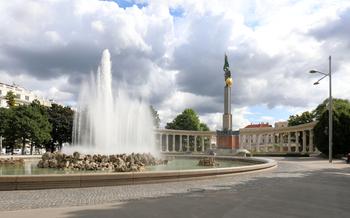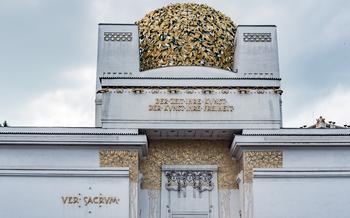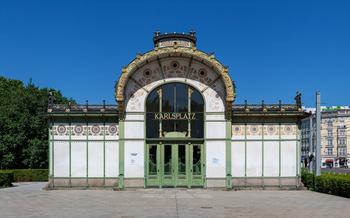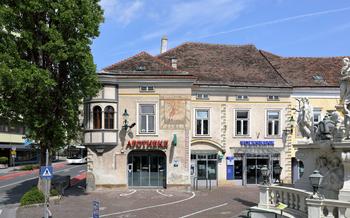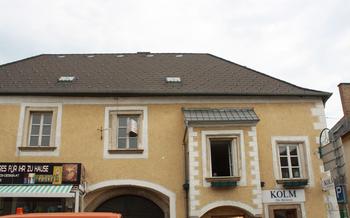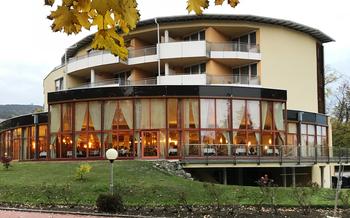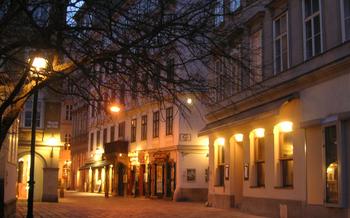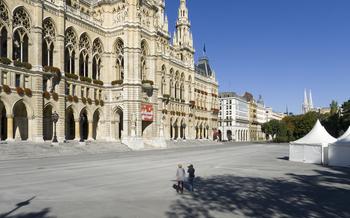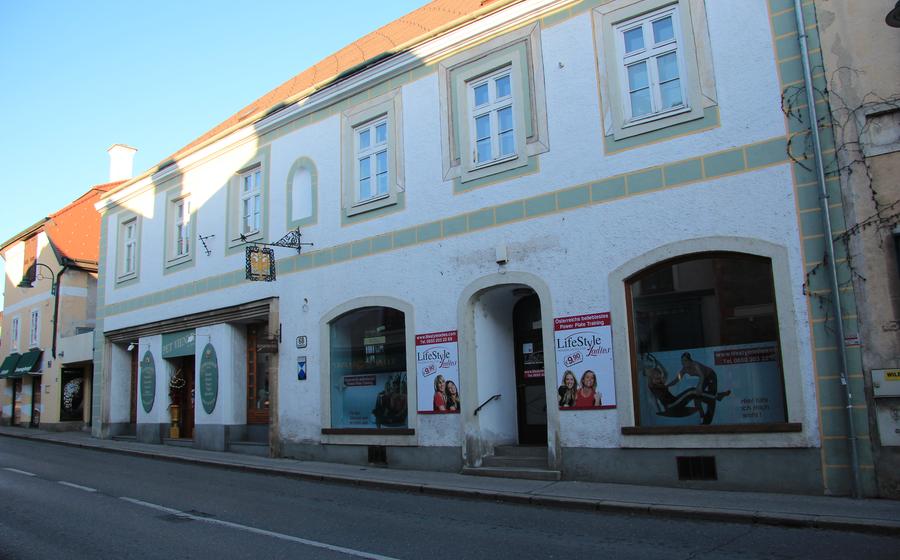
Vienna Secession Building
- The Vienna Secession Building
- Historical Significance
- Architectural Features
- The Secessionist Movement
- Gustav Klimt:
- Exhibitions and Events
- Nearby Attractions
- Historical Context of Vienna
- Art Nouveau Architecture
- Secessionist Artists
- The Role of the Building
- Gustav Klimt's Murals
- Modern Exhibitions
- Insider Tip
The Vienna Secession Building
The Vienna Secession Building, an architectural masterpiece of the Art Nouveau movement, stands as a testament to the artistic and cultural transformation that swept through Vienna in the late 19th century. Designed by Joseph Maria Olbrich, a prominent member of the Secession movement, the building was completed in 1898 and served as the headquarters for the group, which sought to break away from the traditional artistic norms and embrace new, progressive forms of art. The Secession Building, with its distinctive golden dome and intricate ornamentation, became a symbol of the movement's ideals and a hub for artistic activity in Vienna.
Historical Significance
The Vienna Secession Building stands as a testament to Vienna's artistic and cultural transformation in the late 19th century. Its construction coincided with a period of intense creativity and innovation, as artists sought to break free from traditional academic norms and embrace new artistic styles. The building's conception and design were heavily influenced by Gustav Klimt, one of the most prominent figures of the Secessionist movement. Klimt and his fellow artists envisioned the building as a symbol of their commitment to artistic freedom and a rejection of the prevailing conservative artistic establishment.
The Secession Building's status as a symbol of the Secessionist movement was solidified with its completion in 189It quickly became a focal point for artistic activity in Vienna, hosting numerous exhibitions, lectures, and other events. The building's design and its association with the Secessionist movement made it a target of criticism from traditionalists, but it also attracted a large following of supporters who embraced its innovative spirit.
The Vienna Secession Building has survived two World Wars and other historical upheavals, standing as an enduring symbol of artistic freedom and innovation. Its cultural significance has only grown over time, and it is now recognized as one of the most important landmarks of the Secessionist movement and a must-visit destination for anyone interested in the history of art and architecture.
Architectural Features
The Vienna Secession Building stands out for its unique architectural features, reflecting the innovative spirit of the Secessionist movement. The building's most striking element is its golden dome, designed by Joseph Maria Olbrich. The dome is covered in thousands of gold-plated laurel leaves, symbolizing victory and achievement. The facade of the building is adorned with intricate ornamentation, including floral motifs, geometric patterns, and allegorical figures. These decorative elements are not merely ornamental but also convey symbolic meanings, reflecting the Secessionists' rejection of traditional artistic norms and their embrace of new ideas.
The building's use of innovative materials and construction techniques was also groundbreaking for its time. Olbrich employed reinforced concrete, a relatively new material at the time, to create the building's structure. This allowed for the creation of large, open spaces, which were ideal for exhibiting artworks. The building's interior spaces are equally impressive, featuring high ceilings, marble floors, and elegant chandeliers. The exhibition halls, lecture hall, and library are all designed to provide a harmonious and inspiring environment for visitors to experience art and culture.
The Secessionist Movement
The Secessionist movement emerged in Vienna in the late 19th century as a reaction to the conservative artistic establishment of the time. The Secessionists advocated for a break from traditional academic art and sought to promote new, more progressive artistic styles. They believed that art should be free from the constraints of tradition and that artists should have the freedom to express themselves in their own unique way.
The Secessionist movement was founded by a group of artists led by Gustav Klimt, who became its president. Other prominent members included Egon Schiele, Koloman Moser, and Josef Hoffmann. The Secessionists held regular exhibitions at the Vienna Secession Building, which served as a platform for their work and a meeting place for like-minded artists.
The Secessionist movement had a profound impact on the development of modern art in Austria. It helped to introduce new artistic styles and ideas to the country and paved the way for the emergence of Expressionism and other avant-garde movements. The Secessionist movement also had a significant influence on the development of Art Nouveau architecture, which was characterized by its use of organic forms, asymmetry, and intricate ornamentation.
The legacy of the Secessionist movement can still be seen in Vienna today. The Vienna Secession Building remains a symbol of the movement and is one of the city's most popular tourist attractions. The works of the Secessionist artists are displayed in museums and galleries throughout the city, and the movement's influence can be seen in the architecture and design of many of Vienna's buildings.
Gustav Klimt:
Gustav Klimt, one of the most celebrated artists of the Secessionist movement, played a pivotal role in the design and decoration of the Vienna Secession Building. His contributions extended beyond the creation of the striking Beethoven Frieze, which adorned the building's exhibition hall. Klimt's artistic vision left an indelible mark on the building's interior spaces, where he incorporated intricate symbolism and decorative elements that reflected the Secessionist ideals. His famous works of art, such as "The Kiss" and "Judith and Holofernes," were exhibited at the Secession Building, solidifying its status as a hub for avant-garde art. Klimt's influence transcended the Secessionist movement, leaving a lasting impact on Symbolism and Art Nouveau in Austria and beyond.
Exhibitions and Events
The Vienna Secession Building is not merely a historical landmark; it remains a vibrant hub for contemporary art and design. Throughout the year, the building hosts an array of captivating exhibitions, showcasing the works of established and emerging artists from Austria and beyond. These exhibitions encompass a diverse range of artistic styles and media, including paintings, sculptures, installations, and photography.
One of the highlights of the exhibition program is the annual Secession Show, held each spring. This prestigious event presents the latest works by members of the Secession, a group of contemporary artists who uphold the legacy of the original Secessionist movement. The Secession Show provides a unique opportunity to discover new artistic trends and engage with the vibrant Viennese art scene.
In addition to the Secession Show, the building hosts numerous temporary exhibitions throughout the year. These exhibitions often focus on specific themes or movements in art history, shedding light on the development of Austrian and international art. Past exhibitions have featured the works of renowned artists such as Gustav Klimt, Egon Schiele, and Friedensreich Hundertwasser, as well as contemporary masters like Ai Weiwei and Jeff Koons.
The Vienna Secession Building also hosts a variety of events, including lectures, workshops, and performances. These events provide a platform for artists, scholars, and the public to engage in discussions about art, design, and cultural issues. The building's historic auditorium, with its elegant decor and intimate atmosphere, serves as a fitting venue for these events.
Whether you are an art enthusiast, a history buff, or simply someone looking for a unique cultural experience, the Vienna Secession Building is a must-visit destination. Its captivating exhibitions and events offer a glimpse into the rich artistic heritage of Austria and the ongoing vitality of its contemporary art scene.
Nearby Attractions
Located in the heart of Vienna's vibrant cultural district, the Vienna Secession Building is surrounded by a wealth of other cultural attractions. Within a short walking distance, visitors can explore the Leopold Museum, home to a vast collection of Austrian art from the late 19th and early 20th centuries, including works by Klimt, Schiele, and Kokoschka. The Museum of Applied Arts (MAK) is another must-see, showcasing a diverse array of decorative arts and design objects from around the world.
For a unique shopping experience, head to the nearby Naschmarkt, Vienna's largest outdoor market. This bustling market offers a vibrant mix of fresh produce, international cuisine, and vintage treasures. Take a stroll through the market's narrow streets and soak up the lively atmosphere while browsing the stalls for souvenirs and local delicacies.
After a day of exploring, indulge in a delicious meal at one of the many nearby restaurants. From traditional Austrian cuisine to international flavors, there are options to suit every taste. For a memorable dining experience, try Gastwirtschaft Wratschko, a charming restaurant housed in a historic building, or enjoy a leisurely meal at one of the many cafes along Linke Wienzeile, a lively street lined with outdoor seating.
To make the most of your visit, consider creating a self-guided walking tour of the Secession Building and the surrounding area. Start at the Secession Building and explore its unique architecture and exhibitions. From there, stroll along Linke Wienzeile, taking in the sights and sounds of this vibrant neighborhood. Stop at the Leopold Museum and the MAK to admire the works of Austrian masters. Continue your walk to Naschmarkt, where you can soak up the lively atmosphere and browse the market stalls for souvenirs and local delicacies. End your tour with a delicious meal at one of the many nearby restaurants or cafes.
Historical Context of Vienna
Vienna, the capital of Austria, has a rich and storied history that dates back over 2,000 years. The city has been a center of culture and learning for centuries, and it was during the late 19th and early 20th centuries that Vienna experienced a period of artistic and intellectual ferment that gave rise to the Secessionist movement.
The Habsburg Empire, which ruled over Austria for over 600 years, played a pivotal role in the development of Vienna's cultural landscape. The Habsburgs were patrons of the arts and sciences, and they attracted many talented artists and intellectuals to their court. Vienna became a melting pot of different cultures and ideas, and this cosmopolitan atmosphere was conducive to the emergence of new artistic movements.
The late 19th century was a time of great change and upheaval in Europe. The Industrial Revolution had transformed the economy and society, and the old order was beginning to crumble. In the arts, there was a growing dissatisfaction with traditional academic styles, and artists were seeking new ways to express themselves.
The Secessionist movement was a response to these changing times. The Secessionists rejected the traditional artistic norms and sought to create a new art that was more in tune with the modern world. They were inspired by the work of the Impressionists and Post-Impressionists in France, and they also drew on elements of Japanese art and architecture.
The Secessionist movement was a major force in the development of modern art in Austria. It helped to break down the barriers between the different arts, and it encouraged artists to experiment with new forms and techniques. The Secessionist movement also played a role in the development of Viennese culture, and it helped to make Vienna one of the most important cultural centers in Europe.
Keywords: Historical context, Vienna, Habsburg Empire, artistic and intellectual ferment, Secessionist movement, Industrial Revolution, changing times, traditional academic styles, Impressionists, Post-Impressionists, Japanese art and architecture, modern art, Viennese culture.
Art Nouveau Architecture
Art Nouveau, also known as Jugendstil in German, was a style of art and architecture that emerged in the late 19th century. It was a reaction against the prevailing historicism and eclecticism of the time. Art Nouveau artists and architects drew inspiration from nature, using organic forms, asymmetry, and intricate ornamentation in their work.
In Vienna, Art Nouveau architecture flourished during the Secession period. The Secession Building itself is a prime example of Art Nouveau architecture, with its golden dome, intricate facade, and use of innovative materials and construction techniques.
Other notable examples of Art Nouveau architecture in Vienna include the Majolikahaus, the Otto Wagner Postal Savings Bank, and the Kirche am Steinhof. These buildings are characterized by their colorful glazed tiles, sinuous lines, and elaborate metalwork.
Art Nouveau had a profound influence on the development of modern architecture. Its emphasis on organic forms and asymmetry can be seen in the work of architects such as Frank Lloyd Wright and Le Corbusier.
Art Nouveau architecture is still appreciated and preserved today. Many Art Nouveau buildings have been restored and are now open to the public. The Secession Building, for example, is a popular tourist attraction and a UNESCO World Heritage Site.
Secessionist Artists
Beyond Gustav Klimt, the Secessionist movement in Vienna was home to a diverse group of talented artists who made significant contributions to Austrian art. Egon Schiele (1890-1918) was a protégé of Klimt and is known for his expressive and introspective portraits, often characterized by distorted figures and bold lines. Koloman Moser (1868-1918) was a versatile artist who worked in a variety of media, including painting, graphic design, and applied arts. He was a co-founder of the Wiener Werkstätte, a collective of artists and designers dedicated to creating functional and beautiful objects. Josef Hoffmann (1870-1956) was an architect and designer who played a key role in the development of Art Nouveau architecture in Vienna. His buildings, such as the Palais Stoclet in Brussels, are characterized by their elegant lines, geometric forms, and use of rich materials.
These artists, along with many others, contributed to the rich and diverse artistic landscape of Vienna during the late 19th and early 20th centuries. Their works can be found in museums and galleries throughout the city, including the Belvedere Museum, the Albertina Museum, and the Leopold Museum.
The Role of the Building
The Vienna Secession Building played a pivotal role in the history of the Secession movement. It served as the movement's headquarters and provided a space for artists to showcase their work and exchange ideas. The building was a symbol of the Secession movement's commitment to artistic freedom and innovation. It was a place where artists could experiment with new styles and techniques, free from the constraints of traditional academic art.
The Secession Building was also a venue for exhibitions, lectures, and other events. These events helped to promote the Secession movement and its ideals. They also provided a platform for artists to share their work with the public. The building was a hub of artistic activity and a meeting place for artists, critics, and collectors.
The Secession Building continues to play an important role in the Austrian art scene. It is a popular tourist attraction and a venue for a variety of exhibitions and events. The building is a reminder of the Secession movement's legacy and its impact on Austrian art and culture.
Gustav Klimt's Murals
Gustav Klimt, one of the leading figures of the Vienna Secession, created a series of murals for the building that were among his most famous works. These murals, which were completed in 1900, depicted allegorical scenes that celebrated the power and significance of art. The murals were a controversial addition to the building, with some critics finding them to be too radical and unconventional. However, they were also widely praised for their technical skill and artistic vision.
Unfortunately, the murals were destroyed during World War II when the building was bombed. However, thanks to the efforts of dedicated conservators, they have been reconstructed based on Klimt's original designs. Today, visitors to the Secession Building can once again admire these stunning works of art, which offer a glimpse into the mind of one of Austria's most celebrated artists.
Modern Exhibitions
The Secession Building continues to embrace its role as a vibrant hub for artistic expression by hosting a diverse array of exhibitions that showcase both historical and contemporary art. These exhibitions provide a platform for Austrian and international artists to present their works and engage with a global audience. Visitors can immerse themselves in a wide spectrum of artistic styles, from the traditional to the avant-garde, as they explore the building's captivating galleries.
The Secession Building's unique architectural features, characterized by its golden dome and intricate ornamentation, create a striking backdrop for the artwork on display. The harmonious interplay between the building's design and the exhibited pieces enhances the overall experience, allowing visitors to appreciate the artworks within their historical and artistic context.
By presenting a diverse range of exhibitions, the Secession Building remains a vital center for artistic dialogue and exploration. It offers visitors an opportunity to delve into the rich history of the Secession movement while simultaneously experiencing the cutting-edge creations of contemporary artists. Through these exhibitions, the building continues to uphold its legacy as a champion of artistic innovation and creativity.
Insider Tip
To make the most of your visit to the Vienna Secession Building, consider these insider tips:
-
Avoid the crowds: If possible, plan your visit for a weekday, as the building tends to be less crowded during the week.
-
Take a guided tour: The museum offers free guided tours in English and German, which provide valuable insights into the history of the building and the Secessionist movement.
-
Explore the surrounding area: After your visit to the Secession Building, take some time to explore the surrounding area. The Naschmarkt, Vienna's largest outdoor market, is just a short walk away and offers a vibrant atmosphere and a variety of culinary delights.
-
Shop for souvenirs: The Secession Building has a well-stocked gift shop where you can purchase souvenirs and books related to the Secession movement, including postcards, posters, and art books.
